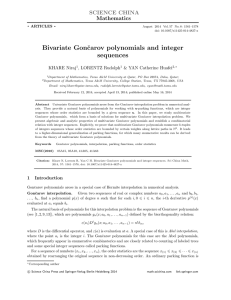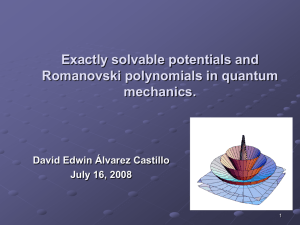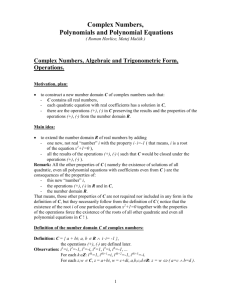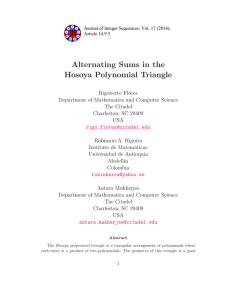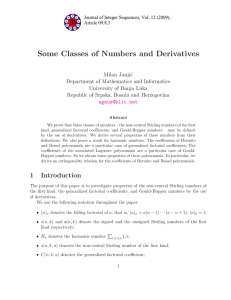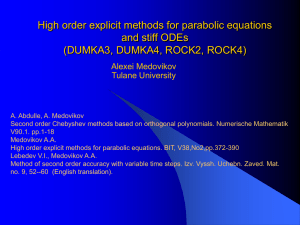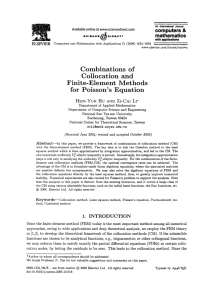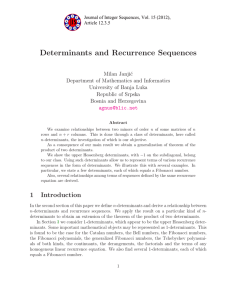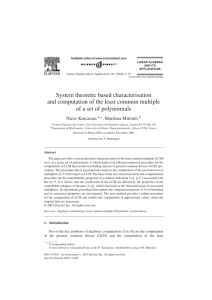Bivariate Affine Gonˇ carov Polynomials Rudolph Lorentz Catherine H. Yan
advertisement
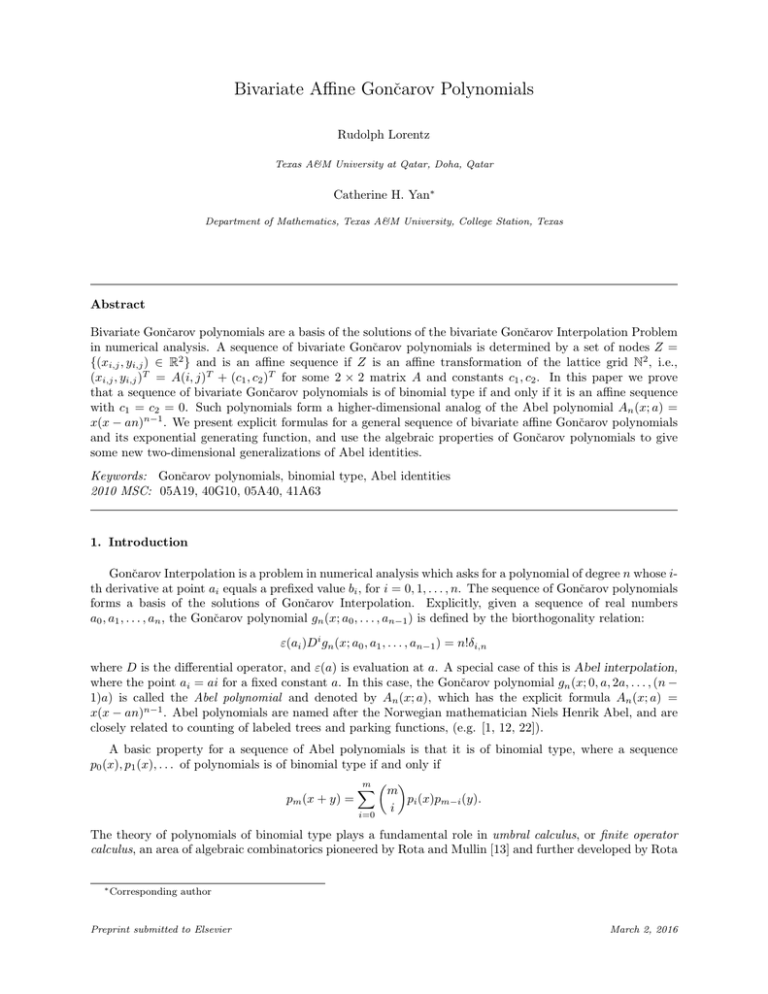
Bivariate Affine Gončarov Polynomials
Rudolph Lorentz
Texas A&M University at Qatar, Doha, Qatar
Catherine H. Yan∗
Department of Mathematics, Texas A&M University, College Station, Texas
Abstract
Bivariate Gončarov polynomials are a basis of the solutions of the bivariate Gončarov Interpolation Problem
in numerical analysis. A sequence of bivariate Gončarov polynomials is determined by a set of nodes Z =
{(xi,j , yi,j ) ∈ R2 } and is an affine sequence if Z is an affine transformation of the lattice grid N2 , i.e.,
(xi,j , yi,j )T = A(i, j)T + (c1 , c2 )T for some 2 × 2 matrix A and constants c1 , c2 . In this paper we prove
that a sequence of bivariate Gončarov polynomials is of binomial type if and only if it is an affine sequence
with c1 = c2 = 0. Such polynomials form a higher-dimensional analog of the Abel polynomial An (x; a) =
x(x − an)n−1 . We present explicit formulas for a general sequence of bivariate affine Gončarov polynomials
and its exponential generating function, and use the algebraic properties of Gončarov polynomials to give
some new two-dimensional generalizations of Abel identities.
Keywords: Gončarov polynomials, binomial type, Abel identities
2010 MSC: 05A19, 40G10, 05A40, 41A63
1. Introduction
Gončarov Interpolation is a problem in numerical analysis which asks for a polynomial of degree n whose ith derivative at point ai equals a prefixed value bi , for i = 0, 1, . . . , n. The sequence of Gončarov polynomials
forms a basis of the solutions of Gončarov Interpolation. Explicitly, given a sequence of real numbers
a0 , a1 , . . . , an , the Gončarov polynomial gn (x; a0 , . . . , an−1 ) is defined by the biorthogonality relation:
ε(ai )Di gn (x; a0 , a1 , . . . , an−1 ) = n!δi,n
where D is the differential operator, and ε(a) is evaluation at a. A special case of this is Abel interpolation,
where the point ai = ai for a fixed constant a. In this case, the Gončarov polynomial gn (x; 0, a, 2a, . . . , (n −
1)a) is called the Abel polynomial and denoted by An (x; a), which has the explicit formula An (x; a) =
x(x − an)n−1 . Abel polynomials are named after the Norwegian mathematician Niels Henrik Abel, and are
closely related to counting of labeled trees and parking functions, (e.g. [1, 12, 22]).
A basic property for a sequence of Abel polynomials is that it is of binomial type, where a sequence
p0 (x), p1 (x), . . . of polynomials is of binomial type if and only if
m X
m
pm (x + y) =
pi (x)pm−i (y).
i
i=0
The theory of polynomials of binomial type plays a fundamental role in umbral calculus, or finite operator
calculus, an area of algebraic combinatorics pioneered by Rota and Mullin [13] and further developed by Rota
∗ Corresponding
author
Preprint submitted to Elsevier
March 2, 2016
and many others, for example, in [2, 3, 5, 14, 20, 21, 19], to list a few. Umbral calculus studies combinatorial
problems by means of linear functionals on spaces of polynomials, and exhibits fascinating relationships
between the formal power series methods of combinatorics, the calculus of finite differences, and the theory
of special polynomials and identities. Polynomials of binomial type also occur naturally in the enumeration
of binomial posets, and are related to graph colorings and acyclic orientations [24, 25, 23].
For multivariate polynomials, there is an analogous notion of polynomial sequences of binomial type, for
which the explicit definition is given in Section 2. The basic theory of polynomial sequences of binomial type
in several variables and their roles in multivariate umbral calculus was developed by Parrish [15]. Garsia and
Joni [6, 9] showed that this theory offers a natural setting for the study of compositional inverses of formal
power series, and used higher dimensional versions of the Lagrange inversion theorem to derive certain new
Steffensen-type formulas. Multivariate umbral calculus and its applications to linear recurrences are studied
by Niederhausen [14].
The multivariate Gončarov polynomials were investigated by Khare, Lorentz and Yan in [11] as a basis
of solutions for the multivariate Gončarov Interpolation. In the current paper we are concerned about
the bivariate case unless otherwise stated. Bivariate Gončarov polynomials are related to pairs of integer
sequences whose order statistics are bounded by certain
weights along lattice paths in N2 . To state the
2
2
definition, let Z be a set of nodes in R , that is, Z = zi,j = (xi,j , yi,j ) ∈ R | 0 ≤ i, 0 ≤ j , and let
m X
n
X
Π2m,n =
ci,j xi y j | ci,j ∈ R
i=0 j=0
be the space of bivariate polynomials of coordinate degree (m, n). The bivariate Gončarov polynomial
gm,n ((x, y); Z) is the unique polynomial in Π2m,n satisfying
∂ i+j
gm,n (zi,j ) = m!n! δi,m δj,n
∂xi ∂y j
(1)
for all 0 ≤ i ≤ m and 0 ≤ j ≤ n. Clearly gm,n ((x, y); Z) depends only on the nodes Zm,n = {zi,j ∈ Z |
0 ≤ i ≤ m, 0 ≤ j ≤ n}. Many algebraic and combinatorial properties of gm,n ((x, y); Z) are given in [11]. In
particular, gm,n ((x, y); Z) can be characterized by the following linear recursion
m n
x y =
n m X
X
m n
i=0 j=0
and the Appell relation
e
sx+ty
=
∞
∞ X
X
i
j
m−i n−j
xi,j
yi,j gi,j ((x, y); Z),
(2)
sm exm,n s tn eym,n t
.
m!
n!
(3)
gm,n ((x, y); Z)
m=0 n=0
Our first objective is to characterize bivariate Gončarov polynomials of binomial type, which would give
a 2-dimensional generalization of the classical Abel polynomials. In Section 2 we present a necessary and
sufficient condition: a sequence of bivariate Gončarov polynomials is of binomial type if and only if the set
of nodes Z is a linear transformation of the standard lattice grid N2 . We call such Gončarov polynomials
linear Gončarov polynomials. In general, if Z is an affine transformation of N2 , the corresponding Gončarov
polynomials are called affine Gončarov polynomials. In Section 3 we calculate the compositional inverses of
the functions appearing in the Appell relations of linear Gončarov polynomials. This allows us to transform
the Appell relation into an exponential generating function for a sequence of linear/affine Gončarov polynomials. Section 4 contains explicit formulas for affine Gončarov polynomials. In the bivariate case the formula
is complete. We also present some examples in the trivariate case. In the last section, we use the algebraic
equations of Gončarov polynomials to derive various combinatorial identities in double summations, which
offer a new family of 2-dimensional generalizations of Riordan’s Abel identities [18].
We remark that in the literature, there are various generalizations of Abel polynomials, starting from
Hurwitz’s multinomial extensions [7] in 1902. The Abel-Hurwitz identities are further investigated by many
2
researchers, including Riordan [18], Françon [4], Pitman [16, 17], Kelmans and Postnikov [10], and are related
to random mappings, subsets, forests, and forest volumes. There were also precedents of Abel polynomials
deriving from finite differences. See [8] for a historical overview. Our generalization as linear Gončarov
polynomials is a totally different approach which provides a new perspective to the subject. Our results are
complementary to the existing research on Abel polynomials and reveal connections between combinatorics,
polynomial systems, and interpolation theory.
2. Gončarov Polynomials of Binomial Type
We adopt Parrish’s definition of multivariate polynomials of binomial type [15].
Definition 1. Let pm,n (x, y) ∈ Πm,n be a sequence of bivariate polynomials satisfying
(a) the degree of pm,n is m + n.
(b) p0,0 (x, y) = 1 and {p0,0 (x, y), p0,1 (x, y), p1,0 (x, y)} span the set of linear polynomials
Then the sequence {pm,n (x, y) | 0 ≤ m, 0 ≤ n} is of binomial type if it satisfies
m X
n X
m n
pm,n (x + a, y + b) =
pi,j (x, y)pm−i,n−j (a, b)
i
j
i=0 j=0
for all m, n ∈ N and a, b ∈ R.
The main result of this section is a characterization of sequences of Gončarov polynomials that are of
binomial type.
Definition 2. We say that a sequence of Gončarov polynomials determined by the set of node Z is affine if
Z is an affine transformation of the lattice grid B = {(i, j) | i, j ∈ N}. In other words, there exists a 2 × 2
matrix A and vector C = (c1 , c2 )T such that
xi,j
i
c1
=A
+
.
yi,j
j
c2
In this case, we will simply say that Z = AB + C. In particular when C = ~0, we say that the corresponding
sequence of Gončarov polynomials gm,n ((x, y); AB) is linear.
Theorem 2.1. A sequence of Gončarov polynomials gm,n ((x, y); Z) is of binomial type if and only if the
sequence is linear. In particular, if A = (ai,j )2×2 , the Appell relation becomes
esx+ty =
∞ X
∞
X
gm,n ((x, y); Z)
m=0 n=0
sm e(a1,1 m+a1,2 n)s tn e(a2,1 m+a2,2 n)t
.
m!
n!
(4)
The proof of Theorem 2.1 uses a result of Parrish, who characterized sequences of multinomial polynomials
of binomial type by their exponential generating functions.
Definition 3. Two formal power series f1 (x, y) and f2 (x, y) are said to be an admissible pair if and only if
1. f1 (0, 0) = 0 and f2 (0, 0) = 0,
2. The Jacobian
J[f1 , f2 ](x, y) = det
∂f1 (x,y)
∂x
∂f2 (x,y)
∂x
∂f1 (x,y)
∂y
∂f2 (x,y)
∂y
!
does not vanish at (x, y) = (0, 0).
Theorem 2.2. (Parrish [15]) A sequence of bivariate polynomials {pm,n (x, y) | 0 ≤ m, 0 ≤ n} is of binomial
type if and only if there exists an admissible pair of formal power series f1 (x, y) and f2 (x, y) such that
∞ X
∞
X
m=0 n=0
pm,n (x, y)
sm tn
= exf1 (s,t)+yf2 (s,t)
m! n!
3
In fact, Parrish showed that the analogous formula holds in any dimension [15, Theorem 1.1].
We shall also use the following well-known result which can be found in [6] or [14]. This result implies
that the set of all admissible pairs of formal power series form a group under composition. This group is
called the umbral group and was studied extensively in [15].
Proposition 2.3. If f1 (s, t) and f2 (s, t) is an admissible pair of formal power series in two variables, then
there exists a unique admissible pair of formal power series h1 (s, t), h2 (s, t), the compositional inverse, such
that
f1 (h1 (s, t), h2 (s, t)) = s,
f2 (h1 (s, t), h2 (s, t)) = t.
If (h1 , h2 ) is inverse to (f1 , f2 ), then (f1 , f2 ) is also inverse to (h1 , h2 ).
Proof of Theorem 2.1. We will use Theorem 2.2 and the Appell relation characterization (3) for Gončarov
polynomials.
Necessity:
Let now the sequence of Gončarov polynomials gm,n (x, y; Z) be of binomial type. This is equivalent to
the existence of an admissible pair of formal power series f1 (x, y) and f2 (x, y) such that
∞ X
∞
X
gm,n (x, y; Z)
m=0 n=0
sm tn
= exf1 (s,t)+yf2 (s,t) .
m! n!
(5)
Using the compositional inverse h1 (s, t) and h2 (s, t) of the pair (f1 (s, t), f2 (s, t)), we can write this expansion
as
∞
∞ X
X
h1 (s, t)m h2 (s, t)n
gm,n (x, y; Z)
= exs+yt .
(6)
m!
n!
m=0 n=0
Comparing this with the Appell relation and using the uniqueness of the coefficients, we have for all m and
n,
h1 (s, t)m h2 (s, t)n = sm exm,n s tn eym,n t .
Taking the same equation with m + 1 replacing m and dividing, we have
h1 (s, t) = se(xm+1,n −xm,n )s e(ym+1,n −ym,n )t ,
which holds for all m and n. It follows that xm+1,n − xm,n is a constant independent of m and n and so
is ym+1,n − ym,n . Similarly, by incrementing n by 1, we obtain that xm,n+1 − xm,n and ym,n+1 − ym,n are
constants independent of m and n.
Let c1 , c2 , c3 and c4 be these constants. By repeating the above first by decreasing m to zero and then
decreasing n to zero, we obtain that
xm,n = mc1 + nc3 + x0,0 ,
ym,n = mc2 + nc4 + y0,0 .
Comparing the (m, n) = (0, 0) terms of the two representations, we get
s0 ex0,0 s t0 ey0,0 t = h1 (s, t)0 h2 (s, t)0 ,
or equivalently,
ex0,0 s ey0,0 t = 1.
This can only hold for all s and t if x0,0 = 0 and y0,0 = 0. So (xm,n , ym,n )T = A(m, n)T with
c1 c3
A=
.
c2 c4
Sufficiency:
Conversely, if a sequence of Gončarov polynomials gm,n ((x, y); Z) is linear with Z = AB for a 2 × 2-matrix
A, then xm,n = a1,1 m + a1,2 n and ym,n = a2,1 m + a2,2 n, where the ai,j are the entries of the matrix A.
4
The Appell relation (3) becomes
∞ X
∞
X
esx+ty =
gm,n ((x, y); Z)
m=0 n=0
sm e(a1,1 m+a1,2 n)s tn e(a2,1 m+a2,2 n)t
.
m!
n!
(7)
Note that
sm e(a1,1 m+a1,2 n)s tn e(a2,1 m+a2,2 n)t = (sea1,1 s+a2,1 t )m (tea1,2 s+a2,2 t )n .
Taking
h1 (s, t) = sea1,1 s+a2,1 t ,
h2 (s, t) = tea1,2 s+a2,2 t ,
(8)
the sequence of polynomials satisfies Equation (6).
1
We check that the pair (h1 , h2 ) of (8) is admissible. Clearly h1 (0, 0) = h2 (0, 0) = 0 and since ∂h
∂s (0, 0) = 1,
∂h2
∂h1
= 0, ∂s (0, 0) = 0 and ∂t (0, 0) = 1, the Jacobian is 1. Thus by Theorem 2.2 (h1 , h2 ) has a
compositional inverse (f1 , f2 ) which is also admissible. Substituting s = f1 (s, t) and t = f2 (s, t) into (6) we
get the equation (5), and hence this sequence of Gončarov polynomials is of binomial type.
∂h1
∂t (0, 0)
Remark. The proof of Theorem 2.1 can be easily extended to any dimension. In particular, a sequence
of univariate Gončarov polynomials is of binomial type if and only if it is a sequence of Abel polynomials,
i.e., an = an for a constant a, and gn (x; a0 , . . . , an−1 ) = An (x; a).
3. Exponential Generating Functions
In this section we give an explicit formula for the exponential generating function of a sequence of bivariate
affine Gončarov polynomials. That is, we will find functions f1 and f2 for which
∞ X
∞
X
gm,n ((x, y); Z)
m=0 n=0
sm tn
= exf1 (s,t)+yf2 (s,t) .
m! n!
(9)
when Z = AB + C. We will deal with the linear case first.
Theorem 3.1. Let A = (ai,j ) be a 2 × 2 matrix and Z = AB. Then we have
f1 (s, t) =
∞
X
(−a1,1 )
m−1
m−1 m
m
m=1
m!
s
+
∞
∞ X
X
(−a2,1 m)
m=1 n=1
(−xm,n )m−1 (−ym,n )n−1 m n
s t
m!
n!
and
f2 (s, t) =
∞
X
(−a2,2 )n−1
n=1
∞ ∞
nn−1 n X X
(−xm,n )m−1 (−ym,n )n−1 m n
t +
s t ,
(−a1,2 n)
n!
m!
n!
m=1 n=1
where xm,n = a1,1 m + a1,2 n and ym,n = a2,1 m + a2,2 n.
Let h1 and h2 be the admissible pair of formal power series defined by
h1 (s, t) = sea1,1 s+a2,1 t ,
h2 (s, t) = tea1,2 s+a2,2 t .
(10)
Then the formal power series (f1 (s, t), f2 (s, t)) in Equation (9) are the compositional inverse for (h1 (s, t), h2 (s, t)).
To compute them we use the Lagrange-Good inversion formula in the following version, which was proved
by Joni [9, Theorem 3.2]. An explicit statement and applications to linear recursions are presented by
Niederhausen [14, Theorem 1.3.2].
5
Theorem 3.2 (Lagrange-Good inversion formula). Let (h1 (s, t), h2 (s, t)) be a multi-series with compositional
inverse (f1 (s, t), f2 (s, t)). If we can write
h1 (s, t) = s/φ1 (s, t)
and
h2 (s, t) = t/φ2 (s, t),
where φ1 (s, t) and φ2 (s, t) are formal power series with φ1 (0, 0) 6= 0 and φ2 (0, 0) 6= 0, then
[sm tn ] f1 (s, t)k f2 (s, t)` = [sm−k tn−` ] φ1 (s, t)m+1 φ2 (s, t)n+1 |J[h1 , h2 ](s, t)|
(11)
for all m, n, k, ` ∈ N. In (11) J[h1 , h2 ] is the Jacobian of h1 and h2 , and [sm tn ]f is the coefficient of the
term xm y n in the expansion of f .
Proof of Theorem 3.1.
With the functions (h1 , h2 ) given in (10), we set
φ1 (s, t) = e−(a1,1 s+a2,1 t) ,
φ2 (s, t) = e−(a1,2 s+a2,2 t) .
Clearly φ1 (s, t) and φ2 (s, t) are formal power series with φ1 (0, 0) = φ2 (0, 0) = 1, and such that
h1 (s, t) =
s
,
φ1 (s, t)
h2 (s, t) =
t
.
φ2 (s, t)
Applying Theorem 3.2 with k = 1 and ` = 0, we get that the compositional inverse (f1 , f2 ) of the pair
(h1 , h2 ) satisfies
[sm tn ](f1 (s, t)) = [sm−1 tn ](φ1 (s, t)m+1 φ2 (s, t)n+1 J[h1 , h2 ](s, t))
for all m, n ∈ N. In the following we compute f1 (s, t) in detail. The computation of f2 (s, t) is similar with
the equation (11) at k = 0 and ` = 1.
For our choice of h1 and h2 ,
J[h1 , h2 ](s, t) = ea1,1 s+a2,1 t ea1,2 s+a2,2 t (1 + a1,1 s + a2,2 t + det(A)st) .
So
φ1 (s, t)m+1 φ2 (s, t)n+1 J[h1 , h2 ](s, t) = e−xm,n s−ym,n t (1 + a1,1 s + a2,2 t + det(A)st) .
Now use that [si tj ](u(s)v(t)) = [si ](u(s))[tj ](v(t)) and linearity to obtain
[sm tn ]f1 (s, t)
=
det(A)[sm−1 ](se−xm,n s )[tn ](te−ym,n t )
+ a1,1 [sm−1 ](se−xm,n s )[tn ](e−ym,n t )
+ a2,2 [sm−1 ](e−xm,n s )[tn ](te−ym,n t )
+
[sm−1 ](e−xm,n s ))[tn ](e−ym,n t ).
In evaluating the above formula, we consider the following four cases.
Case 1: m = 0, n ≥ 0. Since the functions φ1 (s, t), φ2 (s, t) and J[h1 , h2 ](s, t) are formal power series in s, t,
there is no term with s−1 . Hence [s0 tn ](f1 (s, t)) = 0 for all n ≥ 0.
Case 2: n = 0, m ≥ 1. Using [t0 ](tg(t)) = 0 for any formal power series g and xm,0 = a1,1 m, we get
[sm t0 ](f1 (s, t))
= a1,1 [sm−1 ](se−xm,0 s ) + [sm−1 ](e−xm,0 s )) = (−a1,1 )m−1
mm−1
.
m!
Case 3: m = 1, n ≥ 1. Using [s0 ](sg(s)) = 0 for any formal power series g, we get
[s1 tn ]f1 (s, t)
= a2,2 [tn ](te−y1,n t ) + [tn ](e−y1,n t ) = −a2,1
6
(−y1,n )n−1
.
n!
Case 4: m ≥ 2 and n ≥ 1. Now we have
[sm tn ]f1 (s, t)
det(A)[sm−2 ](e−xm,n s )[tn−1 ](e−ym,n t ) + a1,1 [sm−2 ](e−xm,n s )[tn ](e−ym,n t )
=
+a2,2 [sm−1 ](e−xm,n s )[tn−1 ](e−ym,n t ) + [sm−1 ](e−xm,n s ))[tn ](e−ym,n t )
(−xm,n )m−2 (−ym,n )n
(−xm,n )m−2 (−ym,n )n
+ a1,1
(m − 2)! (n − 1)!
(m − 2)!
n!
m−1
n
m−1
(−xm,n )
(−ym,n )
(−xm,n )
(−ym,n ))n
+a2,2
+
(m − 1)! (n − 1)!
(m − 1)!
n!
m−2
n−1
(−xm,n )
(−ym,n )
=
(m − 1)!
n!
·{(m − 1)n det(A) − (m − 1)a1,1 ym,n − na2,2 xm,n + xm,n ym,n }.
=
det(A)
The quantity in brackets {} simplifies to a2,1 xm,n , so that
[sm tn ]f1 (s, t) = (−a2,1 )
(−xm,n )m−1 (−ym,n )n−1
(m − 1)!
n!
for m ≥ 2 and n ≥ 1.
Putting everything together, we have
f1 (s, t)
∞
X
=
(−a1,1 )m−1
m=1
∞
∞ X
X
+
∞
mm−1 m X
(−y1,n )n−1 n
s +
(−a2,1 )
st
m!
n!
n=1
(−a2,1 m)
m=2 n=1
(−xm,n )m−1 (−ym,n )n−1 m n
s t
m!
n!
where xm,n = a1,1 m + a1,2 n and ym,n = a2,1 m + a2,2 n. Note that the second sum is just the m = 1 term of
the following double sum, so
f1 (s, t)
=
∞
X
m−1 m
(−a1,1 )
m=1
m−1
m!
m
s +
∞
∞ X
X
(−a2,1 m)
m=1 n=1
(−xm,n )m−1 (−ym,n )n−1 m n
s t .
m!
n!
The formula of f2 (s, t) is obtained similarly.
Note that if the grid of nodes is a rectangular one, i.e., if A is a diagonal matrix with a2,1 = a1,2 = 0,
then f1 (s, t) = f1 (s, 0) and f2 (s, t) = f2 (0, t) are univariate inverses of h1 (s, 0) = sea1,1 s , respectively
h2 (0, t) = tea2,2 t . In that case f1 (s, t) = (1/a1,1 )W (a1,1 s) and f2 (s, t) = (1/a2,2 )W (a2,2 t), where W (s) is the
well-known Lambert W-function
∞
X
(−n)n−1 n
W (s) =
s .
n!
n=1
Using the shift invariant formula of Gončarov polynomials in [11, Theorem 3.8],
gm,n ((x + c1 , y + c2 ); Z + (c1 , c2 )) = gm,n ((x, y); Z),
we obtain the exponential generating function for a sequence of affine Gončarov polynomials.
Corollary 3.3. When Z = AB + C where C = (c1 , c2 )T , the exponential generating function for the affine
Gončarov polynomials is
∞ X
∞
X
m=0 n=0
gm,n ((x, y); Z)
sm tn
= e(x−c1 )f1 (s,t)+(y−c2 )f2 (s,t) ,
m! n!
where f1 (s, t) and f2 (s, t) are given in Theorem 3.1.
7
4. Closed formula for affine Gončarov polynomials
Recall that a univariate Gončarov polynomial is affine if and only if the nodes form an arithmetic
progression. In this case gn (x; a, a + b, a + 2b, . . . , a + (n − 1)b) = (x − a)(x − a − nb)n−1 is the shifted Abel
polynomials An (x − a; b). In this section we present the explicit formula for the affine Gončarov polynomials
in two variables, and some special cases in three variables. Again we start with the linear case. The formula
was first conjectured based on explicit calculation with small indices, and then verified in the following
theorem.
Theorem 4.1. Let m, n ∈ N, A = (ai,j ) be a 2 × 2 matrix and Z = AB be a set of interpolation nodes.
Then the linear bivariate Gončarov polynomials with the set of nodes Z are given by
gm,n ((x, y); Z) = (x − xm,n )m−1 (y − ym,n )n−1 [(x − x0,n )(y − ym,0 ) − x0,n ym,0 ] ,
(12)
where xi,j = a1,1 i + a1,2 j, yi,j = a2,1 i + a2,2 j for all i, j ∈ N.
Proof. Denote by Gm,n (x, y) the right-hand side of (12). We use the defining interpolation equations (1) for
Gončarov polynomials and check that for 0 ≤ i ≤ m and 0 ≤ j ≤ n
∂ i+j
Gm,n (xi,j , yi,j ) = m!n!δi,m δj,n .
∂xi ∂y j
(13)
It is easy to compute that
∂i
(x − xm,n )m−1 (x − x0,n )
i
∂x
m!
if i = m,
=
(m − 1)i−1 (x − xm,n )m−1−i (mx − (m − i)x0,n − ixm,n ) if i < m,
where for a nonnegative integer k the symbol (x)k is the lower factorial (x)k = x(x − 1)(x − 2) · · · (x − k + 1).
For x = xi,j = a1,1 i + a1,2 j,
∂i
(x − xm,n )m−1 (x − x0,n )
i
∂x
x=xi,j
m!
if i = m,
=
(14)
(m − 1)i−1 (xi,j − xm,n )m−1−i · a1,2 m(j − n) if i < m.
Similarly, for y = yi,j = a2,1 i + a2,2 j,
=
∂j
(y − ym,n )n−1 (y − ym,0 )
i
∂j
y=yi,j
n!
(n − 1)j−1 (yi,j − ym,n )n−1−j · a2,1 n(i − m)
if j = n,
if j < n.
Using (14) and (15) we see immediately that
∂ m+n
Gm,n (x, y) = m!n!
∂xm ∂y n
∀(x, y)
and
∂ i+j
Gm,n (x, y) = 0
∂xi ∂y j
if i = m and j < n, or i < m and j = n. Finally when 0 ≤ i < m and 0 ≤ j < n, we have
∂ i+j
G
(x,
y)
m,n
∂xi ∂y j
(x,y)=(xi,j ,yi,j )
= (m − 1)i−1 (n − 1)j−1 (xi,j − xm,n )m−1−i (yi,j − ym,n )n−1−j
{a1,2 a2,1 mn(m − i)(n − j) − (m − i)(n − j)x0,n ym,0 }.
The term in the { } vanishes since x0,n = a1,2 n and ym,0 = a2,1 m.
8
(15)
Remark. When A is a diagonal matrix, i.e., a1,2 = a2,1 = 0, gm,n ((x, y); AB) is a product of two univariate
Abel polynomials in the variables x and y. Precisely,
gm,n ((x, y), AB) = Am (x; a1,1 )An (y; a2,2 ).
When a1,2 = 0 but a2,1 6= 0, gm,n ((x, y); AB) can also be factored into a product of an Abel polynomial in
x and a shifted Abel polynomial in y, as
gm,n ((x, y), AB) = Am (x; a1,1 )An (y − a2,1 m; a2,2 ).
A similar equation holds for the case a1,2 6= 0 but a2,1 = 0. In general, linear Gončarov polynomials cannot
be factored as a product of univariate polynomials of x and y. Hence (12) offers a new generalization of the
classical Abel polynomials.
The shift invariant formula leads to the closed formula for affine Gončarov polynomials in two variables.
Corollary 4.2. Let Z = AB + C where A is a 2 × 2 matrix and C = (c1 , c2 )T , Then the affine bivariate
Gončarov polynomials with the node-set Z are given by
gm,n ((x, y); Z) = (x − xm,n )m−1 (y − ym,n )n−1 {(x − x0,n )(y − ym,0 ) − (x0,n − x0,0 )(ym,0 − y0,0 )}
where xi,j = a1,1 i + a1,2 j + c1 , yi,j = a2,1 i + a2,2 j + c2 for all i, j ∈ N.
In Section 2 we have shown that a sequence of Gončarov polynomials is of binomial type if and only if it
is linear. This assertion is true in any dimension. However, we do not have a complete description for linear
Gončarov polynomials in general dimensions, except for some special cases with three variables, which are
given below. To simplify notations, we will write xi,j,k as xijk , and so on.
Theorem 4.3. Let m, n, p be nonnegative integers, A = (ai,k ) be a 3 × 3-matrix and the set of nodes Z be
given by Z = {(xijk , yijk , zijk )T = A(i, j, k)T | 0 ≤ i, 0 ≤ j, 0 ≤ k}.
If one of the conditions
1.
2.
3.
4.
5.
a1,3
a1,2
a1,2
a2,1
a3,1
= a2,1
= a2,3
= a1,3
= a2,3
= a3,2
= a3,2 = 0
= a3,1 = 0
= 0 and a2,3 a3,2 = 0.
= 0 and a1,3 a3,1 = 0.
= 0 and a1,2 a2,1 = 0.
holds, then
gm,n,p ((x, y, z); Z)
=
(x − xmnp )m−1 (y − ymnp )n−1 (z − zmnp )p−1
{(x − x0np )(y − ym0p )(z − zmn0 ) + x0np ym0p zmn0 }
(16)
is the trivariate linear Gončarov polynomial with the node-set Z.
Theorem 4.3 is proved by using the interpolation definition for Gončarov polynomials [11] and verifying
that the function gm,n,p ((x, y, z); Z) defined by (16) satisfies the equations
∂ i+j+k
gm,n,p ((xijk , yijk , zijk )) = m!n!p!δi,m δj,n δk,p .
∂xi ∂y j ∂z k
(17)
for 0 ≤ i ≤ m, 0 ≤ j ≤ n and 0 ≤ k ≤ p.
We remark that the possible choices of the matrix A allow placing the nodes of interpolation on a plane
or a line, (i.e., A is degenerate). If A is diagonal, gm,n,p ((x, y, z); AB) is the product of three univariate Abel
polynomials in the variables x, y and z. While in the cases 3, 4, and 5 above, gm,n,p ((x, y, z); AB) can be
factorized into three univariate polynomials, one is an Abel polynomial and two are shifted Abel polynomial.
Again using the shift invariance of Gončarov polynomials, we have
9
Corollary 4.4. Let Z = AB +C where A is a 3×3 matrix and C = (c1 , c2 , c3 )T . If one of the five conditions
in Theorem 4.3 holds, then the affine bivariate Gončarov polynomials for interpolation at the nodes Z are
given by
gm,n,p ((x, y, z); Z)
(x − xmnp )m−1 (y − ymnp )n−1 (z − zmnp )p−1
=
{(x − x0np )(y − ym0p )(z − zmn0 )
+(x0np − x000 )(ym0p − y000 )(zmn0 − z000 )},
where (xijk , yijk , zijk )T = A(i, j, k)T + (c1 , c2 , c3 )T for all i, j, k ∈ N.
5. Two-dimensional Abel Identities
In his monograph Combinatorial Identities, John Riordan studied a class of sums defined by
An (x, y; p, q) =
n X
n
k=0
k
(x + k)k−p (y + n − k)n−k+q ,
and gave explicit formulas for many An (x, y; p, q)’s with small values of (p, q). Riordan’s results were summarized in [18, Section 1.5] and named Abel identities, since the instance with p = −1, q = 0 is Abel’s
celebrated generalization of the binomial theorem:
x
−1
n
(x + y + na) =
n X
n
k=0
k
(x + ka)k−1 (y + (n − k)a)n−k .
In this section we use the bivariate affine Gončarov polynomials to derive combinatorial identities in double
summations, which can be viewed as a two-dimensional generalization of Abel identities. Explicitly, we
consider the double summation
s t x y
Am,n
α β γ δ
m
n
X X mn
(s + j)m−i+α (t + i)n−j+β (x + (n − j))i+γ (y + (m − i))j+δ .
(18)
=
i
j
i=0 j=0
We will present explicit formulas for the case α = β = γ = δ = 0 and the case that exactly one of α, β, γ, δ
is −1 and others are 0. These formulas reduce the double summations of (18) into single summations, which
can be computed out at certain specializations.
First we list some basic properties of the sum Am,n .
5.1. Basic Properties of Am,n
Initial values.
s
α
t
β
x
γ
s t x y
= sα tβ xγ y δ ,
α β γ δ
1 β
1 δ
y
α β γ δ
= s t x y s(1 + ) + x(1 + ) ,
δ
y
t
s
α
t
β
x
γ
y
δ
A0,0
A1,0
and
A0,1
1
1
= sα tβ xγ y δ t(1 + )γ + y(1 + )α .
x
s
10
Symmetry.
Replacing i with m − i and j with n − j yields that
s t x y
x y
Am,n
= Am,n
α β γ δ
γ δ
s
α
t
β
s
α
t+1
x
β
γ+1
Recurrence.
Using Pascal’s identity
m
m−1
m−1
=
+
,
i
i
i−1
we have
Am,n
s
α
t
β
x
γ
y
δ
=
Am−1,n
s
α+1
t
β
x
γ
y+1
δ
+ Am−1,n
y
δ
y
δ+1
.
(19)
.
(20)
Similarly,
Am,n
s
α
t
β
x
γ
y
δ
=
Am,n−1
s
α
t
β+1
x+1
γ
y
δ
+ Am,n−1
s+1 t
α
β
x
γ
On the other hand,
s t x y
α β γ δ
(m,n) X
m n
=
(s + j)(s + j)m−i−1+α (t + i)n−j+β (x + n − j)i+γ (y + m − i)j+δ
i
j
(i,j)=(0,0)
s
t x y
= sAm,n
α−1 β γ δ
(m,n−1) X
m n−1
(s + j)m−i−1+α (t + i)n−j+β (x + n − j)i+γ (y + m − i)j+δ
+n
i
j−1
(i,j)=(0,0)
s
t x y
s+1 t x
y
= sAm,n
+ nAm,n−1
α−1 β γ δ
α−1 β γ δ+1
Am,n
(21)
Analogously, expanding other factors leads to
Am,n
Am,n
Am,n
s
α
t
β
x
γ
y
δ
s
α
t
β
x
γ
y
δ
s
α
t
β
x
γ
y
δ
=
xAm,n
=
tAm,n
=
yAm,n
y
δ
y
δ
y
δ−1
s
α
t
β
x
γ−1
s
α
t
β−1
x
γ
s
α
t
β
x
γ
11
+ nAm,n−1
+ mAm−1,n
+ mAm,n−1
s
α
t
β+1
x+1
γ−1
y
δ
s
α
t+1
β−1
x
γ+1
y
δ
y+1
δ−1
s
α+1
t
β
x
γ
(22)
(23)
(24)
Remark. Sometimes one is interested in the following summation with parameters b and c:
s t x y
Am,n
; b, c
α β γ δ
m X
n X
m n
=
(s + bj)m−i+α (t + ci)n−j+β (x + (n − j)b)i+γ (y + (m − i)c)j+δ .
i
j
i=0 j=0
Such a summation can be obtained by the equation
sb tc xb yc
s
Am,n
; b, c = bm+α+γ cn+β+δ Am,n
α β γ
δ
α
t
β
x
γ
y
δ
.
5.2. Formula for the case α = β = γ = δ = 0
We use the linear recursion (2) for bivariate Gončarov polynomials. Let Z = {(xi,j , yi,j : i ≥ 0, j ≥ 0} be
given by
xi,j
s
0 1
i
=
+
.
yi,j
t
1 0
j
Using Corollary 4.2 and replacing x with x + s, y with y + t, we derive from (2) the identity
(m,n)
(x + s)m (y + t)n
X
=
(i,j)=(0,0)
m n
(s + j)m−i (t + i)n−j
i
j
·(x − j)i−1 (y − i)j−1 ((x − j)(y − i) − ij)
(25)
This is the key identity in our derivation.
Let
fm,n (x, y)
= Am,n
(m,n)
X
=
s t x−n y−m
0 0
0
0
m n
(s + j)m−i (t + i)n−j (x − j)i (y − i)j ,
i
j
(26)
(i,j)=(0,0)
where we view s, t as constants and x, y as variable. First, it is easy to compute that
fm,0 (x, y) = (s + x)m
and
f0,n (x, y) = (y + t)n .
(27)
Note that
∂2
fm,n (x, y) =
∂x∂y
(m,n)
X
(i,j)=(0,0)
ij
m n
(s + j)m−i (t + i)n−j (x − j)i−1 (y − i)j−1 .
i
j
Hence Identity (25) implies that
(x + s)m (y + t)n = fm,n (x, y) −
∂2
fm,n (x, y).
∂x∂y
Let hm,n (x, y) = fm,n (x, y) − (x + s)m (y + t)n . Then
hm,n (x, y) = mn(x + s)m−1 (y + t)n−1 +
Comparing with (28), we notice that
1
mn hm,n
∂2
hm,n (x, y),
∂x∂y
satisfies the same differential equation as fm−1,n−1 .
12
(28)
Consider the solution for the homogeneous differential equation
F (x, y) = k
If F (x, y) =
P
i,j
∂2
F (x, y).
∂x∂y
(29)
ai,j xi y j , then we have the relations that
(
ai,j =
1
kj
1
ki
ai−j,0
(i)j j!
aj−i,0
(j)i i!
if i ≥ j,
if i < j.
The only polynomial solution of (29) is F (x, y) = 0. Since both hm,n (x, y) and fm−1,n−1 (x, y) are polynomials
of x and y, we conclude that
hm,n (x, y) = mnfm−1,n−1 (x, y).
Therefore we have the recurrence
fm,n (x, y) = (x + s)m (y + t)n + mnfm−1,n−1 (x, y)
(m, n ≥ 1).
(30)
Combining with the initial conditions (27), we obtain
min(m,n)
X
fm,n (x, y) =
(m)k (n)k (s + x)m−k (t + y)n−k .
(31)
k=0
Let
F (u, v) :=
X
fm,n
m,n≥0
um v n
.
m! n!
Then from (31) we have
F (u, v) =
X
uk v k
k≥0
X [u(s + x)]m−k X [v(t + y)]n−k
eu(x+s)+v(y+t)
=
.
(m − k)!
(n − k)!
1 − uv
(32)
n≥k
m≥k
In terms of Am,n , we have that
Theorem 5.1.
Am,n
s
0
t x
0 0
y
0
min(m,n)
=
X
(m)k (n)k (s + x + n)m−k (t + y + m)n−k ,
(33)
k=0
and the generating function
X
m,n≥0
Am,n
s
0
t x−n
0
0
y−m
0
eu(x+s)+v(y+t)
um v n
=
.
m! n!
1 − uv
Note the similarity of Formula (33) with Riordan’s Abel identity of An (x, y; 0, 0), which was also called
Cauchy’s formula and given in [18, Formula (24), Chapter 1]:
An (x, y; 0, 0) =
n
X
(n)k (x + y + n)n−k .
k=0
13
5.3. Formula for α = −1 and β = γ = δ = 0
Using the recurrence relations of Am,n and Theorem 5.1, we can obtain the closed formula for another
case, namely, when exactly one of α, β, γ, δ is −1 and the others are 0. We work out the details with α = −1
and β = γ = δ = 0.
In (21), applying (24) to the second term, we have
s t x y
Am,n
α β γ δ
s
t x y
s+1 t x
y
= sAm,n
+ nAm,n−1
α−1 β γ δ
α−1 β γ δ+1
s
t x y
= sAm,n
+
α−1 β γ δ
s+1 t x y
s+1 t
n yAm,n−1
+ mAm−1,n−1
α−1 β γ δ
α
β
x
γ
y+1
δ
Hence
sAm,n
s
α−1
t
β
x
γ
y
δ
+ nyAm,n−1
s
= Am,n
α
s+1
α−1
t
β
t
β
y
δ
x
γ
x
γ
y
δ
− mnAm−1,n−1
When α = β = γ = δ = 0, using (33) one computes that
s t x y
s+1 t x
Am,n
− mnAm−1,n−1
0 0 0 0
0
0 0
y+1
0
Therefore (34) leads to the identity
s t x y
s+1
sAm,n
+ nyAm,n−1
−1 0 0 0
−1
y
0
t x
0 0
s+1 t
α
β
x
γ
y+1
δ
. (34)
= (s + x + n)m (t + y + m)n .
= (s + x + n)m (t + y + m)n .
(35)
The general formula of Am,n with (α, β, γ, δ) = (−1, 0, 0, 0) can be obtained by iterating the recurrence (35)
with the initial value
s t x y
Am,0
= s−1 (s + x)m .
−1 0 0 0
For example,
Am,1
s
−1
Am,2
t x
0 0
y
t+y+m
s t x y
m
−
.
= (x + s + 1)
−1 0 0 0
s
s(s + 1)
2y(t + y + m)
y2
(t + y + m)2
y
−
+
.
= (s + x + 2)m
0
s
s(s + 1)
s(s + 1)(s + 2)
In general, we have
Theorem 5.2.
Am,n
s
−1
t x
0 0
y
0
=
(s + x + n)
m
n
X
(−1)i (n)i
(t + y + m)n−i y i
(s
+
i)
i+1
i=0
!
.
When s = 1, the formula (36) is much simpler. In that case, (s + i)i+1 = (1 + i)!, and hence
Corollary 5.3.
Am,n
1
−1
t x
0 0
y
0
=
m
(1 + x + n)
n
X
(−1)i (n)i
i=0
=
(1 + i)!
!
n−i i
(t + y + m)
y
(1 + x + n)m
((t + y + m)n+1 − (t + m)n+1 ).
(n + 1)y
14
(36)
Note that one can not take s = 0 directly in (35) since s is not allowed to be zero when α = −1 in the
defining equation (18) of Am,n .
5.4. Final Remark
We conclude the paper by briefly mentioning another interesting case where the matrix A is degenerate,
i.e.,
a ab
A=
.
ca cab
Applying the same techniques as in the preceding subsections, we obtain a simpler expression for the following
double summation. Let
(m,n)
X
Bm,n (s, t, x, y) =
(i,j)=(0,0)
m n
(s + i + bj)m−i (t + i + bj)n−j
i
j
·(x − i − bj)i (y − i − bj)j−1
(37)
Then we have
Bm,n (s, t, x, y; b)
=
n
(t + y)
m
X
(−1)i (m)i
i=0
(y)i+1
!
m−i
(s + x)
i
(y − x)
.
(38)
Note that Bm,n (s, t, x, y; b) is independent of b. In particular, when y = −1, (y)i+1 = (−1)i+1 (i + 1)!.
Therefore we obtain the closed formula
Bm,n (s, t, x, −1; b) =
(t − 1)n
(s − 1)m+1 − (s + x)m+1 .
(1 + x)(1 + m)
(39)
We skip the details of computation.
Acknowledgments
We are grateful to the anonymous referees for reading the manuscript carefully and helping us improve
the presentation of the paper. We are indebted to one of the referees who pointed out that not only were
there generalizations of Abel polynomials, but that there were precedents of falling factorial type.
This publication was made possible by NPRP grant #[5-101-1-025] from the Qatar National Research
Fund (a member of Qatar Foundation). The statements made herein are solely the responsibility of the
authors.
References
[1] W. Y.C. Chen, J.F.F. Peng, H.R.L. Yang. Decomposition of Triply Rooted Trees. Electron. J. Combin.
Volumn 20, Issue 2 (2013), Paper 10.
[2] A. Di Bucchianico, D. E. Loeb, G.-C. Rota. Umbral calculus in Hilbert space. Mathematical essays
in honor of Gian-Carlo Rota (Cambridge, MA, 1996), 213-238, Progr. Math., 161, Birkhuser Boston,
Boston, MA, 1998.
[3] J. Fillmore and S. Williamson. A linear algebra setting for the Rota-Mullin theory of polynomials of
binomial type. Linear and Multilinear Algebra 1(1973), 67–80.
[4] J. Françon. Preuves combinatoires des identités d’Abel. Discrete Math. 8 (1974), 331–343.
15
[5] A. M. Garsia. An expose of the Mullin-Rota theory of polynomials of binomial type. Linear and Multilinear Algebra 1 (1973), 47–65.
[6] A. M. Garsia and S. A. Joni, Higher dimensional polynomials of binomial type and formal power series
inversion, Comm. Algebra, Volume 6 (1978), no. 12, 1187–1215.
[7] A. Hurwitz, Uber Abel’s Verallgemeinerung der binomischen Formel, Acta Mathematica 26 (1902),
199–203.
[8] W. Johnson, The Pfaff/Cauchy derivative identities and Hurwitz type extensions, Ramanujan J (2007)
13 (2007), 167–201,
[9] S. A. Joni. Lagrange inversion in higher dimensions and umbral operators. Linear and Multilinear
Algebra 6 (1978/79), no. 2, 111–122.
[10] A. Kelmans and A. Postnikov. Generalizations of Abel’s and Hurwitz’s identities. European J. Combin.
29 (2008), no. 7, 1535–1543.
[11] N. Khare, R. Lorentz and C. Yan, Bivariate Goncarov polynomials and integer sequences, Sci. China
Math. Volume 57 Issue 8(2014), 1561–1578.
[12] J.P.S Kung and C.H. Yan. Gončarov polynomials and parking functions. J. Combin. Theory Ser. A, 102
(2003), 16–37.
[13] R. Mullin and G.-C. Rota. On the foundations of combinatorial theory. III. Theory of binomial enumeration. 1970 Graph Theory and its Applications (Proc. Advanced Sem., Math. Research Center, Univ.
of Wisconsin, Madison, Wis., 1969) pp. 167–213, Academic Press, New York.
[14] H. Niederhausen. Finite operator calculus with applications to linear recursions. Available online at
http://math.fau.edu/niederhausen/HTML/Research/UmbralCalculus/bookS2010.pdf.
[15] C. Parrish, Multivariate umbral calculus. Linear and Multilinear Algebra 6 (1978/79), no. 2, 93–109.
[16] J. Pitman. Random mappings, forests, and subsets associated with Abel-Cayley-Hurwitz multinomial
expansions. Sém. Lothar. Combin. 46 (2001/02), Art. B46h, 45 pp.
[17] J. Pitman. Forest volume decompositions and Abel-Cayley-Hurwitz multinomial expansions. J. Combin.
Theory Ser. A 98 (2002), no. 1, 175–191.
[18] J. Riordan. Combinatorial Identities, New York: Wiley, 1968.
[19] S. M. Roman, G.-C. Rota. The umbral calculus. Advances in Math. 27 (1978), no. 2, 95–188.
[20] G.-C. Rota. Finite Operator Calculus. Academic Press, New York, 1975.
[21] G.-C. Rota, D. Kahaner and A. Odlyzko. On the foundations of combinatorial theory. VIII. Finite
operator calculus. J. Math. Anal. Appl. 42 (1973), 684–760.
[22] B. Sagan. A note on Abel polynomials and rooted labeled forests. Discrete Math. 44(1983), 293–298.
[23] J. Schneider. Polynomial Sequences of Binomial-Type Arising in Graph Theory. Electronic Journal of
Combinatorics, 21(2014), issue 1, Paper #P1.43.
[24] R. Stanley. Enumerative Combinatorics, volume 1, second edition, Cambridge University Press, 2011.
[25] R. Stanley. Polynomial sequences of binomial type Talk presented at 2012 Shanghai Conference on
Algebraic Combinatorics, August 2012 and University of Miami, January 2013.
16
